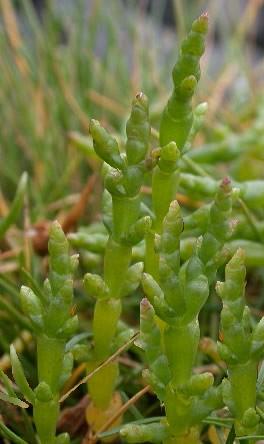
Samphire
Encyclopedia

- Rock samphireRock samphireSamphire or rock samphire, Crithmum maritimum, is the sole species of the genus Crithmum. It is an edible wild plant found on southern and western coasts of Britain and Ireland, on mediterranean and western coasts of Europe including the Canary Islands, North Africa and the Black Sea...
, Crithmum maritimum is a coastal species with white flowers that grows in the United KingdomUnited KingdomThe United Kingdom of Great Britain and Northern IrelandIn the United Kingdom and Dependencies, other languages have been officially recognised as legitimate autochthonous languages under the European Charter for Regional or Minority Languages...
. This is probably the species mentioned by Shakespeare in King LearKing LearKing Lear is a tragedy by William Shakespeare. The title character descends into madness after foolishly disposing of his estate between two of his three daughters based on their flattery, bringing tragic consequences for all. The play is based on the legend of Leir of Britain, a mythological...
. - Golden samphireGolden samphireThe Golden samphire is a perennial coastal species, which may be found growing on salt marsh or sea cliffs across Eurasia....
, Inula crithmoides is a coastal species with yellow flowers that grows across EurasiaEurasiaEurasia is a continent or supercontinent comprising the traditional continents of Europe and Asia ; covering about 52,990,000 km2 or about 10.6% of the Earth's surface located primarily in the eastern and northern hemispheres...
. - Marsh samphire is another name given to the edible glasswortGlasswortSalicornia is a genus of succulent, halophyte plants that grow in salt marshes, on beaches, and among mangroves. Salicornia species are native to North America, Europe, South Africa, and South Asia...
s, genusGenusIn biology, a genus is a low-level taxonomic rank used in the biological classification of living and fossil organisms, which is an example of definition by genus and differentia...
Salicornia. - Samphire is commonly used to describe plants from the AustraliaAustraliaAustralia , officially the Commonwealth of Australia, is a country in the Southern Hemisphere comprising the mainland of the Australian continent, the island of Tasmania, and numerous smaller islands in the Indian and Pacific Oceans. It is the world's sixth-largest country by total area...
n genus of succulent coastal plants Tecticornia, and from the cosmopolitan genus SarcocorniaSarcocorniaSarcocornia is a genus of succulent salt tolerant coastal plants.-Species:*S. alpini*S. blackiana *S. fruticosa*Sarcocornia globosa...
.
Etymology
Originally "sampiere", a corruption of the French "Saint Pierre" (Saint PeterSaint Peter
Saint Peter or Simon Peter was an early Christian leader, who is featured prominently in the New Testament Gospels and the Acts of the Apostles. The son of John or of Jonah and from the village of Bethsaida in the province of Galilee, his brother Andrew was also an apostle...
), Samphire was named for the patron saint of fishermen because all of the original plants with its name grow in rocky salt-sprayed regions along the sea coast of northern Europe or in its coastal marsh areas. It is sometimes called sea asparagus
Asparagus
Asparagus officinalis is a spring vegetable, a flowering perennialplant species in the genus Asparagus. It was once classified in the lily family, like its Allium cousins, onions and garlic, but the Liliaceae have been split and the onion-like plants are now in the family Amaryllidaceae and...
or sea pickle
Pickle
Pickling is a process of preserving food. Pickle or pickling may refer to:-Food:* Pickled cucumber* Pickled onion* Pickled herring* Indian pickle includes oil-based food preservation* Branston and similar sweet pickle relishes...
, in Norfolk it is commonly called sampha [sam-fa]
All the plants bearing the name are annuals that begin growing in late autumn and vegetate throughout the winter until the first warm weather arrives. Then the first stems and internodes form, and by mid-spring the plant measures 6 to 8 cm.
Uses
Marsh samphire ashes were used to make soap and glass (hence its other old English name, "glasswort.") In the 14th century glassmakers located their workshops near regions where this plant grew, since it was so closely linked to their trade.Samphires of all kinds have long been eaten in England. The leaves were gathered early in the year and pickled or eaten in salads with oil and vinegar. It is mentioned by Shakespeare in King Lear:
- Half-way down Hangs one that gathers samphire; dreadful trade! (Act IV, Scene VI)
This refers to the dangers involved in collecting rock samphire on sea cliffs.
Marsh samphire genus salicornia bigelovii is being investigated as a potential biodiesel
Biodiesel
Biodiesel refers to a vegetable oil- or animal fat-based diesel fuel consisting of long-chain alkyl esters. Biodiesel is typically made by chemically reacting lipids with an alcohol....
source that can be grown in coastal areas where conventional crops cannot be grown.

